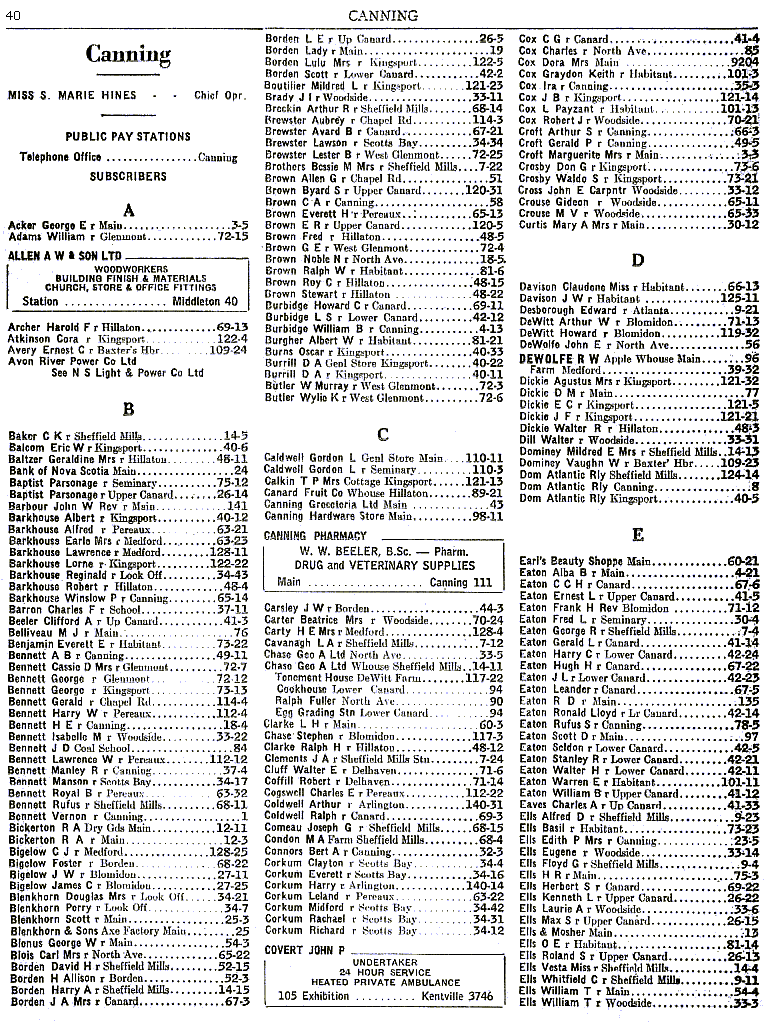|
Private line telephones:
|
nbr. |
|
Bank of Nova Scotia
|
24 |
|
J.D. Bennett, coal dealer
|
84 |
|
Vernon Bennett
|
1 |
|
Blenkhorn & Sons Axe Factory
|
25 |
|
Lady Borden
|
19 |
|
Dominion Atlantic Railway, Canning station
|
8 |
|
Ells & Mosher
|
13 |
|
Nova Scotia Light & Power Company, Canning
|
46 |
Very few of these telephones were connected to a "private line".
A private line service had just one telephone connected.
An inspection of the telephone numbers shown in this 1954 phone book
reveals that all but one of the private-line telephones connected to the
Canning Exchange were located in Canning itself.
The only private-line service outside of Canning was to telephone
number 94 in Lower Canard. Two phones in two separate buildings were connected
to this line, but it qualifies as a private line because there was only one subscriber
– both phones were used by the same business.
There were no private-line telephones in Kingsport, or Blomidon, or
Sheffield Mills. The reason is that a private line required two wires to be
installed, to be used only for this one telephone, all the way from the Telephone
Exchange building (on Main Street in Canning) to the location of the private-line phone.
If a business in Kingsport wanted a private-line phone, the telephone
company would have to install a two-wire circuit from the Canning Exchange to
the Kingsport business office; this circuit could not be used for any purpose
other than that one telephone.
A party line to Kingsport or Scotts Bay or Sheffield Mills required the
same two-wire circuit as a private line, but the cost of the circuit could be
divided among all of the phones on the party line.
In the case of a private line, the entire cost of the circuit had to be
charged to one subscriber. This made a private-line telephone connection
more expensive than a party line connection.
|
Party line telephones:
Most of these telephones were on a "party line".
A party line had two or more telephones, in two or more homes or
businesses, connected together in series. (A "series"
connection is well known to everyone who works with electricity.
It means that the same electric current circulates through all the
connected components.) The same electric current travelled through
all of the telephones on a party line, which meant that anyone listening at any
of the telephones could hear whatever was being said by anyone else on that line.
A party line could have ten or fifteen connected telephones, and some
party lines had as many as twenty.
It was the policy of the telephone company that no party-line telephone
number would have a digit greater than five. For example, consider 128-25,
the phone number (above) for C.J. Bigelow in Medford. You asked for this number
by saying "one twenty eight ring twenty five" – meaning
that the operator would connect to circuit (line) 128 and then, to that line,
would deliver two long rings (for the first digit, 2) and five short rings
(for the second digit, 5). Every telephone on that circuit would sound
two long and five short rings. Everyone within earshot of any of these phones
would have to stop whatever they were doing to count the rings. When the ringing
was completed, the called telephone would be answered, and the others would not (unless
someone wanted to listen in). The point is this, if you had telephone 128-25,
you would have to count the rings to know if there four short rings or five –
only four meant 128-24, not your number, while five meant 128-25, and this call was
for you. Likewise, whoever had phone number 128-24 had to count the rings, to
know if this was their call or not. With fifteen or twenty telephones on one
party line, every phone sounded every ring for all phones on that line. If the phone
numbers were assigned numbers like 128-
|
Party line customers had a special form of telephone number.
117-22 was phone number 22 on party line 117.
140-14 was phone number 14 on party line 140.
40-5 was phone number 5 on party line 40.
For example:
42-2 (S. Borden, Lower Canard)
42-4 (C.F. Weisner, Lower Canard)
42-5 (S. Eaton, Lower Canard)
42-11 (W.H. Eaton, Lower Canard)
42-24 (H.C. Eaton, Lower Canard)
were all on the same party line.
Note that all of these are located in Lower Canard.
A party line served a particular geographic location.
One party line [42-nn] was built southward through Lower Canard,
another [34-nn] was built northward toward Scotts Bay,
others [9-nn, 14-nn, 52-nn, 68-nn] westward toward Sheffield Mills, and so on.
|
